|
a photo discussion page by Don Roberson
A brief look at those wild dogs I've encountered to date in sub-Saharan
Africa |
|
Bat-eared Fox Otocyon megalotis
Bat-eared Fox is a fairly widespread and locally common jackal-like
canine in east and south Africa. Pairs and small groups (i.e., a pair and
offspring) live near burrows, some of which they dig themselves and others
which they expropriate from other critters. They are apparently both nocturnal
and diurnal; my own observations have generally been early in the morning
or late in the afternoon. They prey primarily on termites, beetles, and
invertebrates. "Subterranean insects are located by sound, with the ears
pitched horizontally to get a fix before rapid excavation. The very dense
fur helps protect against the bites of soldier termites;" Kingdon (1997).
It has more teeth than any non-marsupial mammal that serve to demolish
hard-shelled invertebrate prey, such as scorpions and beetles. There are
two disparate populations — one in east Africa and the other in south Africa
— possibly because they require open habitats, rather than woodlands. All
my encounters have been in savannah or along the edges of dry rivercourses
in very broken, open woodland.
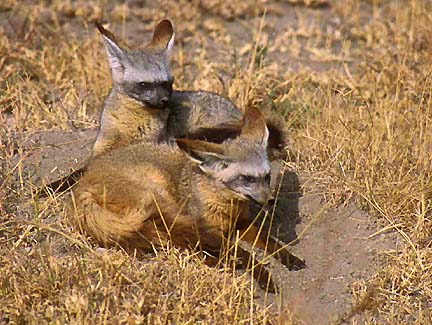
pair 11 Aug 2002 Ndutu, Tanzania
|
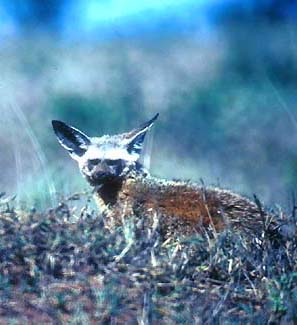
male Nov 1981 West Tsavo NP, Kenya
|
|
|
|
Golden Jackal Canis aureus
adult 8 Aug 2002
Ngorongoro Crater, Tanzania
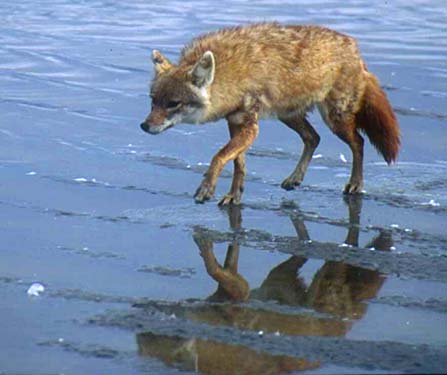 The
Golden (or Common) Jackal is the widespread jackal of north Africa, southern
Europe, and east to India and southeast Asia. It reminds me, an American,
of our coyotes. This one (right) was scavenging along the lakeshore in
Ngorongoro Crater looking for the remains of dead or injured flamingos
or waterfowl. The generally form mated pairs and defend a territory; cooperative
hunting between pairs increases success. This is very much an open, dry
country jackal but subsists well around villages, and territoriality may
break down where food is abundant, as at village garbage dumps. We've seen
it in those situations in Corbett NP, north India, for example. In Africa,
it reaches its limit of southward distribution in northern Tanzania. The
Golden (or Common) Jackal is the widespread jackal of north Africa, southern
Europe, and east to India and southeast Asia. It reminds me, an American,
of our coyotes. This one (right) was scavenging along the lakeshore in
Ngorongoro Crater looking for the remains of dead or injured flamingos
or waterfowl. The generally form mated pairs and defend a territory; cooperative
hunting between pairs increases success. This is very much an open, dry
country jackal but subsists well around villages, and territoriality may
break down where food is abundant, as at village garbage dumps. We've seen
it in those situations in Corbett NP, north India, for example. In Africa,
it reaches its limit of southward distribution in northern Tanzania. |
|
|
Black-backed Jackal Canis mesomelas
Kingdon (1997) argues this canine might better be called the "Acacia
Jackal" because its range encompasses the open Acacia woodlands of east
and southern Africa. However, especial in southern Africa, it occupies
a broader variety of habitats, from wetter woodlands to arid Kalahari desert
dune-woodland. The pairs studied by Mark & Delia Owens (1984) in the
Kalahari Desert of Botswana were permanent residents in this arid environment
that endures long stretches of hot, dry periods without rain. Except where
there is overlap with the previous species, this is a vocal jackal, yowling
at dusk each evening. Mated pairs form permanent pair-bonds and hunt cooperatively;
they are often accompanied by the prior season's young (at least in east
Africa). In some places, the local name is "Silver-backed Jackal." While
the species does regularly scavenge from kills made by larger predators,
it is an aggressive predator in its own right, taking on birds as large
as bustards, small antelope, and large snakes. It can sometimes be seen
out in the open during the day.
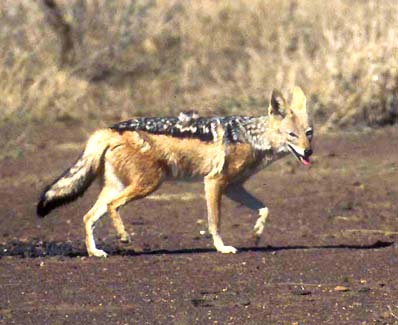
male July 1996 Kruger NP, South Africa
|
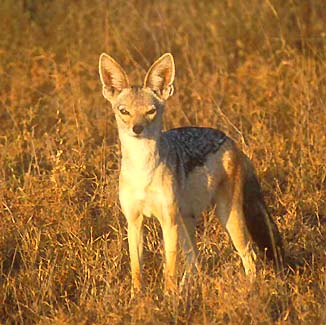
male 11 Aug 2002 Ndutu, Tanzania
|
|
|
Side-striped Jackal Canis adustus
pair 11 Aug 2002
Ndutu, Tanzania
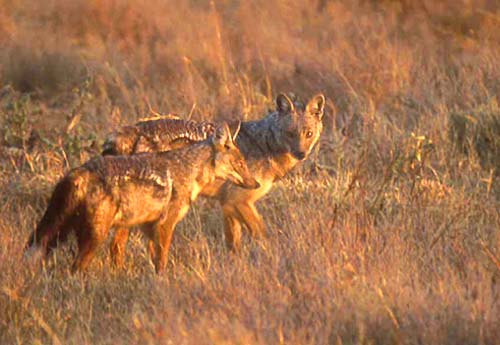 Side-striped
Jackal is mostly a secretive, nocturnal species and thus rarely seen. My
only encounter is documented by this photo of a pair in dry savanna at
the edge of woodland, just after dawn. Note the pale eyes and shorter ears
than the previous species. It hunts small mammals and birds, but also takes
fruit. Although my observation was in dry country, it generally prefers
wetter areas than the other jackals and ranges across central Africa, but
is missing from the arid portions of southern Africa. It replaces Golden
Jackal at higher elevations or in swampy habitat. Like other jackals, pairs
defend territories but individuals often hunt solitarily. It apparently
occupies the "tropical fox" niche in central Africa (Kingdon 1997). Side-striped
Jackal is mostly a secretive, nocturnal species and thus rarely seen. My
only encounter is documented by this photo of a pair in dry savanna at
the edge of woodland, just after dawn. Note the pale eyes and shorter ears
than the previous species. It hunts small mammals and birds, but also takes
fruit. Although my observation was in dry country, it generally prefers
wetter areas than the other jackals and ranges across central Africa, but
is missing from the arid portions of southern Africa. It replaces Golden
Jackal at higher elevations or in swampy habitat. Like other jackals, pairs
defend territories but individuals often hunt solitarily. It apparently
occupies the "tropical fox" niche in central Africa (Kingdon 1997). |
|
|
African Wild Dog Lycaon pictus
adult July 1996
Kruger NP, South Africa
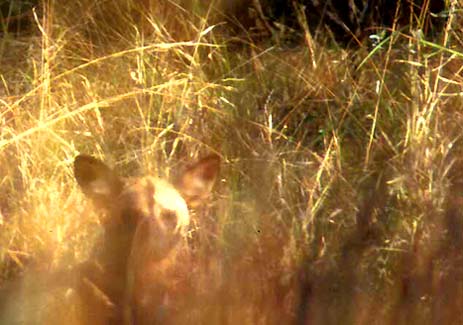 The
Wild Dog is a pack hunter of the open plains and the African savanna woodlands.
Alas, it has been in serious decline for years. Humans aggressively exterminate
it in non-protected areas, and even in parks it is very susceptible to
canine distemper picked up from feral, non-native dogs. My only encounter
was with a small pack lying in tall grass in the shade of a wooded glen
in eastern South Africa. We were among a dozen or more cars of visitors
trying to get a view: this was about it. They are beautiful animals mottled
with black, gold, buff, and white. The
Wild Dog is a pack hunter of the open plains and the African savanna woodlands.
Alas, it has been in serious decline for years. Humans aggressively exterminate
it in non-protected areas, and even in parks it is very susceptible to
canine distemper picked up from feral, non-native dogs. My only encounter
was with a small pack lying in tall grass in the shade of a wooded glen
in eastern South Africa. We were among a dozen or more cars of visitors
trying to get a view: this was about it. They are beautiful animals mottled
with black, gold, buff, and white.
Antelope form the bulk of their diet on the open plains where packs
run down and overpower prey. Pups and adults that remain at a den are fed
later by regurgitation. Mark & Delia Owens (1984) report some fascinating
behavior during their irregular encounters in the Kalahari Desert of Botswana.
A wild pack would tolerate an upright human moving slowly in their midst,
but if the person crouched down, members of the pack would immediately
begin to stalk him.
"The social arrangements of African wild dogs are extraordinary because
they are the exact opposite of those in most other social mammals, such
as as coatis, baboons, lions and elephants. With the wild dog pack all
the males are related to each other, and all of the females to each other
but not to the males. Females migrate into the pack, whereas males stay
with their natal pack." Males outnumber females about 2:1 in each pack
and help raise the young. It is the females that fight to breed. Indeed,
only the dominant male and female breed in most situations; other females
that produce litters are driven from the pack and are unlikely to survive
(Malcolm 1985). |
|
|
| PHOTOS: All photos on this page are © 2005 Don Roberson;
all rights reserved.
Literature cited:
Kingdon, J. 1997. The Kingdon Field Guide to African Mammals.
Academic Press, London.
Malcolm, J. 1985. "African Wild Dogs" in The Encyclopedia of
Mammals (D. W. Macdonald, ed.). Facts on File Press, New York.
Owens, M., and D. Owens. 1984. Cry of the Kalahari. Houghton Mifflin,
Boston.
TOP
TO MAMMALS
PAGE
TO BIRD FAMILIES
OF THE WORLD
TO HOME PAGE
|

